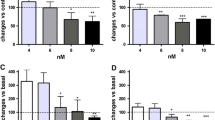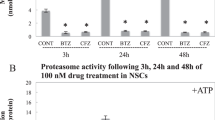Abstract
Bortezomib is a reversible proteasome inhibitor used as an anticancer drug. However, its clinical use is limited since it causes peripheral neurotoxicity. We have used Sprague–Dawley rats as an animal model to investigate the cellular mechanisms affected by both short-term and chronic bortezomib treatments in sensory ganglia neurons. Proteasome inhibition induces dose-dependent alterations in the architecture, positioning, shape and polarity of the neuronal nucleus. It also produces DNA damage without affecting neuronal survival, and severe disruption of the protein synthesis machinery at the central cytoplasm accompanied by decreased expression of the brain-derived neurotrophic factor. As a compensatory or adaptive survival response against proteotoxic stress caused by bortezomib treatment, sensory neurons preserve basal levels of transcriptional activity, up-regulate the expression of proteasome subunit genes, and generate a new cytoplasmic perinuclear domain for protein synthesis. We propose that proteasome activity is crucial for controlling nuclear architecture, DNA repair and the organization of the protein synthesis machinery in sensory neurons. These neurons are primary targets of bortezomib neurotoxicity, for which reason their dysfunction may contribute to the pathogenesis of the bortezomib-induced peripheral neuropathy in treated patients.







Similar content being viewed by others
References
Finley D (2009) Recognition and processing of ubiquitin-protein conjugates by the proteasome. Annu Rev Biochem 78:477–513
Adams J (2004) The development of proteasome inhibitors as anticancer drugs. Cancer Cell 5:417–421
Schwartz AL, Ciechanover A (2009) Targeting protein for destruction by the ubiquitin system: implications for human pathobiology. Annu Rev Pharmacol Toxicol 49:73–96
Steffen J, Seeger M, Koch A, Krüger E (2010) Proteasomal degradation is transcriptionally controlled by TCF11 via an ERAD-dependent feedback loop. Mol Cell 40:147–158
Rubinsztein DC (2006) The roles of intracellular protein-degradation pathways in neurodegeneration. Nature 443:780–786
Ding Q, Cecarini V, Keller JN (2006) Interplay between protein synthesis and degradation in the CNS: physiological and pathological implications. Trends Neurosci 30:31–36
Lehman NL (2009) The ubiquitin proteasome system in neuropathology. Acta Neuropathol 118:329–347
Bennett EJ, Bence NF, Jayakumar R, Kopito RR (2005) Global impairment of the ubiquitin-proteasome system by nuclear or cytoplasmic protein aggregates precedes inclusion body formation. Mol Cell 17:351–365
Bedford L, Hay D, Devoy A, Paine S, Powe DG, Seth R, Gray T, Topham I, Fone K, Rezvani N, Mee M, Soane T, Layfield R, Sheppard PW, Ebendal T, Usoskin D, Lowe J, Mayer RJ (2008) Depletion of 26S proteasomes in mouse brain neurons causes neurodegeneration and Lewy-like inclusions resembling human pale bodies. J Neurosci 28:8189–8198
Misteli T, Spector DL (2011) The Nucleus. Cold Spring Harbor Laboratory Press, New York
Mekhail K, Moazed D (2010) The nuclear envelope in genome organization, expression and stability. Nat Rev Mol Cell Biol 11:317–328
Oberdoerffer P, Sinclair DA (2007) The role of nuclear architecture in genomic instability and ageing. Nat Rev Mol Cell Biol 8:692–702
Dauer WT, Worman HJ (2009) The nuclear envelope as a signaling node in development and disease. Dev Cell 17:626–638
von Mikecz A (2006) The nuclear ubiquitin-proteasome system. J Cell Sci 119:1977–1984
Lafarga M, Berciano MT, Pena E, Mayo I, Castano JG, Bohmann D, Rodrigues JP, Tavanez JP, Carmo-Fonseca M (2002) Clastosome: a subtype of nuclear body enriched in 19S and 20S proteasomes, ubiquitin, and protein substrates of proteasome. Mol Biol Cell 13:2771–2782
Desterro JM, Rodriguez MS, Hay RT (2000) Regulation of transcription factors by protein degradation. Cell Mol Life Sci 57:1207–1219
Rockel TD, Stuhlmann D, von Mikecz A (2005) Proteasomes degrade proteins in focal subdomains of the human cell nucleus. J Cell Sci 118:5231–5242
Richardson PG, Mitsiades C, Hideshima T, Anderson KC (2006) Bortezomib: proteasome inhibition as an effective anticancer therapy. Annu Rev Med 57:33–47
McConkey DJ, Zhu K (2008) Mechanisms of proteasome inhibitor action and resistance in cancer. Drug Resist Updates 11:164–179
Cavaletti G, Gilardini A, Canta A, Rigamonti L, Rodriguez-Menendez V, Ceresa C, Marmiroli P, Bossi M, Oggioni N, D′Incalci M, De Coster R (2007) Bortezomib-induced peripheral neurotoxicity: a neurophysiological and pathological study in the rat. Exp Neurol 204:317–325
Casafont I, Berciano MT, Lafarga M (2010) Bortezomib induces the formation of nuclear poly(A) RNA granules enriched in Sam68 and PABPN1 in sensory ganglia neurons. Neurotox Res 17:167–178
Bruna J, Urdina E, Ale A, Vilches JJ, Vynckier A, Monbaliu J, Silverman L, Navarro X (2010) Neurophysiological, histological and immunohistochemical characterization of bortezomib-induced neurophathy in mice. Exp Neurol 223:599–608
Carozzi VA, Canta A, Oggioni N, Sala B, Chiorazzi A, Meregalli C, Bossi M, Marmiroli P, Cavaletti G (2010) Neurophysiological and neuropathological characterization of new murine models of chemotherapy-induced chronic peripheral neuropathies. Exp Neurol 226:301–309
Argyriou AA, Bruna J, Marmiroli P, Cavaletti G (2012) Chemotherapy-induced peripheral neurotoxicity (CIPN): an update. Crit Rev Oncol Hematol 8:51–77
Pena E, Berciano MT, Fernandez R, Ojeda JL, Lafarga M (2001) Neuronal body size correlates with the number of nucleoli and Cajal bodies, and with the organization of the splicing machinery in rat trigeminal ganglion neurons. J Comp Neurol 430:250–263
Casafont I, Navascues J, Pena E, Lafarga M, Berciano MT (2006) Nuclear organization and dynamics of transcription sites in rat sensory ganglia neurons detected by incorporation of 5′-fluorouridine into nascent RNA. Neuroscience 140:453–462
Binder DK, Scharfman HE (2004) Brain-derived neurotrophic factor. Growth Factor 22:123–131
Holcomb PS, Deerinck T, Ellisman MH, Spirou GA (2013) Construction of a polarized neuron. J Physiol 591:3145–3150
Jacquemont C, Taniguchi T (2007) Proteasome function is required for DNA damage response and fanconi anemia pathway activation. Cancer Res 67:7395–7405
Sakasai R, Teraoka H, Tibbetts RS (2010) Proteasome inhibition suppresses DNA-dependent protein kinase activation caused by camptothecin. DNA Repair (Amst) 9:76–82
Fernandez-Capetillo O, Lee A, Nussenzweig M, Nussenzweig A (2004) H2AX: the histone guardian of genome. DNA Repair 3:959–967
Noon AT, Goodarzi AA (2011) 53BP1-mediated DNA double strand break repair: insert bad pun here. DNA Repair 10:1071–1076
Meiners S, Heyken D, Weller A, Ludwig A, Stang K, Kloetzel PM, Krüger E (2003) Inhibition of proteasome activity induces concerted expression of proteasome genes and de novo formation of mammalian proteasomes. J Biol Chem 278:21517–21525
Kühn U, Wahle E (2004) Structure and function of poly(A) binding proteins. Biochim Biophys Acta 1678:67–84
Moreau P, Pylypenko H, Grosicki S, Karamanesht I, Leleu X, Grishunina M, Rekhtman G, Masliak Z, Robak T, Shubina A, Arnulf B, Kropff M, Cavet J, Esseltine DL, Feng H, Girgis S, van de Velde H, Deraedt W, Harousseau JL (2011) Subcutaneous versus intravenous administration of bortezomib in patients with relapsed multiple myeloma: a randomized, phase 3, non-inferiority study. Lancet Oncol 12:431–440
Meregalli C, Canta A, Carozzi VA, Chiorazzi A, Oggioni N, Gilardini A, Ceresa C, Avezza F, Crippa L, Marmiroli P, Cavaletti G (2010) Bortezomib-induced painful neuropathy in rats: a behavioral, neurophysiological and pathological study in rats. Eur J Pain 14:343–350
Casafont I, Palanca A, Lafarga V, Berciano MT, Lafarga M (2011) Effect of ionizing radiation in sensory ganglion neurons: organization and dynamics of nuclear compartments of DNA damage/repair and their relationship with transcription and cell cycle. Acta Neuropathol 122:481–493
Kruhlak M, Crouch EE, Orlov M, Montaño C, Gorski SA, Nussenzweig A, Misteli T, Phair RD, Casellas R (2007) The ATM repair pathway inhibits RNA polymerase I transcription in response to chromosome breaks. Nature 447:730–734
Martin LJ (2008) DNA damage and repair: relevance to mechanisms of neurodegeneration. J Neuropathol Exp Neurol 67:377–387
Baltanas FC, Casafont I, Lafarga V, Weruaga E, Alonso JR, Berciano MT, Lafarga M (2011) Purkinje cell degeneration in pcd mice reveals large scale chromatin reorganization and gene silencing linked to defective DNA repair. J Biol Chem 286:28287–28302
Feng R, Oton A, Mapara MY, Anderson G, Belani C, Lentzsch S (2007) The histone deacetylase inhibitor, PXD101, potentiates bortezomib-induced anti-multiple myeloma effect by induction of oxidative stress and DNA damage. Br J Haematol 139:385–397
Lieberman AR (1971) The axon reaction: a review of the principal features of perikaryal responses to axon injury. Int Rev Neurobiol 14:49–124
De Nicola AF, Labombarda F, Deniselle MC, Gonzalez SL, Garay L, Meyer M, Gargiulo G, Guennoun R, Schumacher M (2009) Progesterone neuroprotection in traumatic CNS injury and motoneuron degeneration. Front Neuroendocrinol 30:173–187
Tapia O, Bengoechea R, Palanca A, Arteaga R, Val-Bernal JF, Tizzano EF, Berciano MT, Lafarga M (2012) Reorganization of Cajal bodies and nucleolar targeting of coilin in motor neurons of type I spinal muscular atrophy. Histochem Cell Biol 137:657–667
Seo H, Sonntag K-C, Isacson O (2004) Generalized brain and skin proteasome inhibition in Huntington’s disease. Ann Neurol 56:319–328
Burke B, Roux KJ (2009) Nuclei take a position: managing nuclear location. Dev Cell 17:587–597
Burke B, Stewart CL (2013) The nuclear lamins: flexibility in function. Nat Rev Mol Cell Biol 14:13–24
Lafarga M, Berciano MT, Martinez-Guijarro FJ, Andres MA, Mellström B, Lopez-Garcia C, Naranjo JR (1992) Fos-like expression and nuclear size in osmotically stimulated supraoptic nucleus neurons. Neuroscience 50:867–875
Wittmann M, Queisser G, Eder A, Wiegert JS, Bengtson CP, Hellwig A, Wittum G, Bading H (2009) Synaptic activity induces dramatic changes in the geometry of the cell nucleus: interplay between nuclear structure, histone H3 phosphorylation, and nuclear calcium signaling. J Neurosci 29:14687–14700
Akhtar A, Gasser SM (2007) The nuclear envelope and transcriptional control. Nat Rev Genet 8:507–517
Palay SL, Chan-Palay V (1974) The cerebellar cortex. Cytology and organization. Springer, New York
Imai S, Kitano H (1998) Heterochromatin islands and their dynamic reorganization: a hypothesis for three distinctive features of cellular aging. Exp Gerontol 33:555–570
Gavilán MP, Pintado C, Gavilán E, García-Cuervo LM, Castaño A, Ríos RM, Ruano D (2012) Age-related differences in the dynamics of hippocampal proteasome recovery. J Neurochem 123:635–644
Acknowledgments
The authors wish to thank Raquel García-Ceballos and María Ruiz Soto for technical assistance. This work was supported by the following grants: “Dirección General de Investigación” of Spain (BFU2011-23983), and “Centro de Investigación Biomédica en Red sobre Enfermedades Neurodegenerativas (CIBERNED; CB06/05/0037)” from Spain.
Author information
Authors and Affiliations
Corresponding author
Rights and permissions
About this article
Cite this article
Palanca, A., Casafont, I., Berciano, M.T. et al. Proteasome inhibition induces DNA damage and reorganizes nuclear architecture and protein synthesis machinery in sensory ganglion neurons. Cell. Mol. Life Sci. 71, 1961–1975 (2014). https://doi.org/10.1007/s00018-013-1474-2
Received:
Revised:
Accepted:
Published:
Issue Date:
DOI: https://doi.org/10.1007/s00018-013-1474-2




